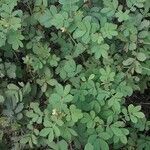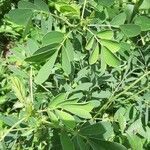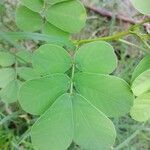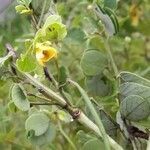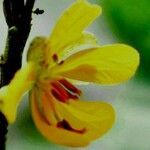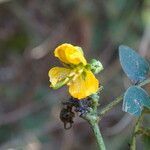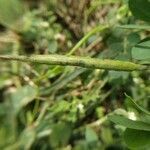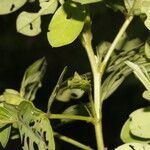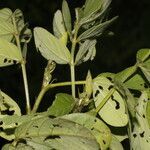Annual or short-lived perennial shrub or woody herb 0.5-2 m tall. Branchlets pale grey-brown, glabrous, longitudinally ridged when young, later terete. Leaves paripinnate; stipules 7-9 mm long, linear, with ciliate margins, caducous; petiole 2.5-3.9 cm long, sparsely pubescent; rachis 1.5-2.6 cm long, sparsely pubescent, glabrescent, with a terete reddish gland 1.5 mm long between the proximal leaflet pair and sometimes a similar but smaller gland between the middle leaflet pair; leaflets in (2)3 pairs, 2.9-5.7 x 1.8-2.9 cm (smaller in stunted or dry-season material), the distal largest, broadly elliptic to broadly obovate, base cuneate or rounded, slightly asymmetric, apex obtuse to rounded or retuse, often mucronate, glabrous except for the pubescent margin and scattered hairs on the midrib beneath; petiolules 1-2 mm long, pubescent. Inflorescences axillary, 1-2-flowered; bracts 3-4 mm long, linear, with ciliate margins, caducous; peduncle very short; pedicels 1.2-2 cm long at anthesis. Hypanthium with reddish glands. Sepals 5, two c. 8 x 5 mm, three 5-6 x 3-4 mm, elliptic to obovate, glabrous except for the ciliate margins which also bear scattered reddish glands. Petals orange to yellow, 14-16 x 7-9 mm, including a claw c. 2 mm long, obovate, slightly unequal. Stamens 10; three fertile with anthers 4-5 mm long and filaments 3-4 mm long, four fertile with anthers c. 2 mm long and filaments c. 2 mm long; two trumpet-shaped staminodes 3 mm long and one linear staminode c. 2 mm long. Ovary c. 15 mm long, terete, appressed-pubescent; style 2-2.5 mm long, glabrous; stigma terminal, oblique, trumpet-shaped. Pod 13-20 x 0.5-0.7 cm, linear, falcately curved or straight, elliptic in section, acuminate at apex, tardily dehiscent along both sutures. Seeds olive-brown, c. 5 x 2-3 mm, rhomboid, with a linear areole on each broad face.
Herb or undershrub up to 1 m tall, rarely higher (2.5 m), usually foetid smelling, glabrous or thinly pubescent. Stipules setaceous, 10-15 mm, caducous. Leaves with 3 pairs of leaflets; petiole 1-4 cm; rachis 2-3 cm, with a subulate, 2 mm long gland between the lowest pair of leaflets. Leaflets obovate, shortly petiolulate; membranous, 1-6 by 0.5-4 cm, increasing in size distally, apex rounded and mucronate, base cuneate. Racemes axillary, 1-or 2-(or 3-)flowered on a very short peduncle; bracts linear, acute; pedicels 1.5-3.5 cmlong, elongating to 2-4.5 cm in fruit. Sepals subequal, ovate, 5 by 2-4 mm. Petals yellow-orange, unequal, short-clawed, 1-2 cm long. Stamens 7, nearly equal, filaments 1.5-2 mm, anthers 3 longer, 4 smaller 1.5-2.5 mm, opening by apical pores, the three larger anthers narrowed shortly below the apex like a bottleneck; staminodes 0-3. Pods linear, terete, falcate to straight, 13-23 by 0.4-0.7 cm. Seeds 20-30, ovoid-rhomboid, 5-6 by 2-4 mm with very narrow areoles 3-4.5 by 0.3-0.5 mm.
Herbaceous perennial or subshrub, erect or spreading, to 2 m high but often lower, sparsely pubescent on vegetative parts, calyx and ovary, soon glabrescent. Leaves 4–6 cm long including a channelled petiole 15–20 mm long; stipules lanceolate, acicular, somewhat persistent; leaflets in 2 or 3 pairs spaced 12–15 mm apart, obovate, 40–50 mm long, 20–30 mm wide, markedly increasing distally, obtuse and mucronate; glands 1 or 2, between the lowest leaflet pairs, erect. Inflorescence subumbellate, of 1 or 2 flowers, axillary; peduncle 2–4 mm long; pedicels 15–20 mm long; bracts caducous. Petals 8–10 mm long. Fertile stamens 7, with 3 adaxial staminodes; fertile filaments unequal, 1–4 mm long; fertile anthers unequal, 3–5 mm long, shortly beaked. Pod cylindric, 12–18 cm long, c. 3 mm diam., curved, entire. Seeds dull or lustrous, with a narrow, oblique areole.
An annual or perennial herb. Often it has a bad smell. It can be a shrub 0.6-2.5 m tall. It has slightly hairy stems. The leaf stalk does not have a gland but the axis of the leaf does. The leaf has leaflets in 3 pairs. They are oval and 1-6 cm long by 0.5-3.9 cm wide. The top of the leaf is rounded but with a sharp tip. It is wedge shaped at the base. The flower stalks have one or 2 flowers. The stalk for the flower cluster is very short, but the stalk for the individual flowers is 1-3.5 cm long. The flower petals are orange-yellow and 1-2 cm long. The fruits are thin slightly curved and tapering pods. They are 13-23 cm long and 4-7 mm wide. The seeds are brown. They are 4.5-6.5 cm long by 2-4 mm wide.
Leaves paripinnate; stipules 7–9 mm long, linear, with ciliate margins, caducous; petiole 2.5–3.9 cm long, sparsely pubescent; rachis 1.5–2.6 cm long, sparsely pubescent, glabrescent, with a terete reddish gland 1–1.5 mm long between the proximal leaflet pair and sometimes a similar but smaller gland between the middle leaflet pair; leaflets in (2)3 pairs, 2.9–5.7 × 1.8–2.9 cm (smaller in stunted or dry-season material), the distal largest, broadly elliptic to broadly obovate, base cuneate or rounded, slightly asymmetric, apex obtuse to rounded or retuse, often mucronate, glabrous except for the pubescent margin and scattered hairs on the midrib beneath; petiolules 1–2 mm long, pubescent.
Stamens 10; three fertile with anthers 4–5 mm long and filaments 3–4 mm long, four fertile with anthers c.2 mm long and filaments c.2 mm long; two trumpet-shaped staminodes 2–3 mm long and one linear staminode c.2 mm long.
Annual herb or shrublet, up to 1 m high. Leaves with 3 pairs of leaflets only, with stalked, finger-like, orange-brown gland 2 mm long between 2 lower pairs of leaflets. Flowers yellow and brown-veined.
Inflorescences axillary, 1–2-flowered; bracts 3–4 mm long, linear, with ciliate margins, caducous; peduncle very short; pedicels 1.2–2 cm long at anthesis.
Sepals 5, two c.8 × 5 mm, three 5–6 × 3–4 mm, elliptic to obovate, glabrous except for the ciliate margins which also bear scattered reddish glands.
Pod 13–20 × 0.5–0.7 cm, linear, falcately curved or straight, elliptic in section, acuminate at apex, tardily dehiscent along both sutures.
Ovary c.15 mm long, terete, appressed pubescent; style 2–2.5 mm long, glabrous; stigma terminal, oblique, trumpet-shaped.
Petals orange to yellow, 14–16 × 7–9 mm, including a claw c.2 mm long, obovate, slightly unequal.
Branchlets pale grey-brown, glabrous, longitudinally ridged when young, later terete.
Seeds olive-brown, c.5 × 2–3 mm, rhomboid, with a linear areole on each broad face.
Annual or short-lived perennial shrub or woody herb 0.5–2 m tall.
Hypanthium with reddish glands.

